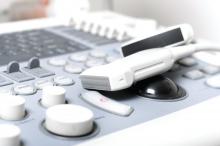Synovitis detected by ultrasound in patients with rheumatoid arthritis (RA) in clinical remission has a moderate but significant independent predictive value for the loss of remission, new research shows.
These findings, reported by Swiss investigators at multiple centers and with different sonographers and ultrasound (US) machines, adds to previous research that has shown that patients in clinical remission with US-detected residual synovitis had a tendency to flare more often and have a shorter duration of remission than did patients with sonographic remission.
However, those studies were limited because they were mostly performed by Doppler mode in single centers by highly skilled operators, Pascal Zufferey, MD, of Lausanne (Switzerland) University Hospital and his colleagues noted in their report published online Jan. 15 in Journal of Rheumatology.“It is currently unknown whether the predictive value of US regarding flares and the duration of remission remains valid in the context of a large group of US assessors using different US machines, as encountered in a real-life setting,” wrote the research team, who conducted the research on behalf of the Swiss Sonography in Arthritis and Rheumatism group and the Swiss Clinical Quality Management in Rheumatic Diseases Foundation.
“Moreover, it remains unclear whether US should be recommended in everyday clinical practice to support therapeutic decisions and to monitor clinical remission,” they added.
In the current study, Dr. Zufferey and his associates analyzed how long 318 RA patients from the Swiss Clinical Quality Management in Rheumatic Diseases cohort remained in remission after they had their first US during remission. The investigators defined loss of remission in this study as either having a 28-joint Disease Activity Score greater than 2.6 or needing to step up treatment with disease-modifying antirheumatic drugs.
The researchers used a previously validated score developed by the Swiss Sonography in Arthritis and Rheumatism group for the definition of US-detected residual synovitis by using cutoffs for B-mode, Doppler, and combined modes that had been defined by previous studies. For example, the cutoffs for significant US-detected residual synovitis were: B-mode of 2 or more joints with synovitis grade of 2 or greater or a total B-mode score greater than 8 points (max score 66 points) and any Doppler activity inside the joint. A combined US synovitis score was defined as B-mode score greater than 8 and/or any Doppler-detected residual synovitis. Patients in clinical remission with a baseline US score above these cutoffs were considered to have significant US-detected residual synovitis (US+), compared with patients who did not have residual synovitis (US–).
The research team observed a loss of remission in 60% of 378 remission phases, with having a 28-joint Disease Activity Score greater than 2.6 deciding the loss of remission status in 66% of cases in both the US+ and the US– groups.
The time from the first US during remission to loss of remission was 2-5 months longer for US– patients than it was for US+ patients.
“After adjusting for potential confounders, [the hazard ratio] of loss of remission for all remission phases using the complete follow-up time was higher for patients with US-detected synovitis at baseline than for those without (combined US score hazard ratio, 1.4; 95% CI, 1.03-2.00 vs. HR, 1.5; 95% CI, 1.1-2.1 for left and right imputation, respectively),” the investigators wrote.
Hazard ratios for the loss of remission also showed a two- to threefold increase when US measurements were taken early in remission (that is, within 3-6 months), a finding that the authors wrote indicated “that the short-term predictive power of US-detected residual synovitis may be more significant than its long-term predictive power.”
The researchers concluded that their study showed that US could be useful in predicting how long patients were likely to remain in remission in “real-life conditions,” but said questions remained over whether it should be used at an individual level.
“According to our results, in particular regarding the moderate HR, a single US done in remission cannot be used as the unique predictor of flare,” they wrote.
Nevertheless, their results may have “some importance in promoting the widespread use of US in real-life conditions for the follow-up of RA, especially when in remission,” they said.
“The next step would be to evaluate whether previous US performed prior to reaching remission and repeated US performed while in remission, particularly after 3-6 months, could provide additional information that is useful to the clinician,” they added.
The Swiss Clinical Quality Management Foundation is supported by the Swiss Society of Rheumatology and nine pharmaceutical companies.
SOURCE: Zufferey P et al. J Rheumatol. 2018 Jan 15. doi: 10.3899/jrheum.161193


